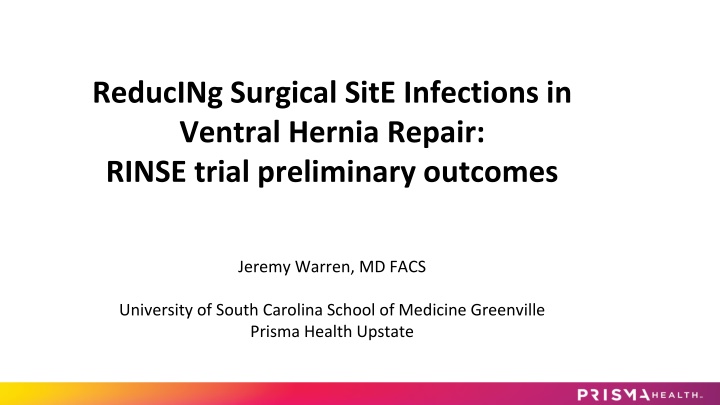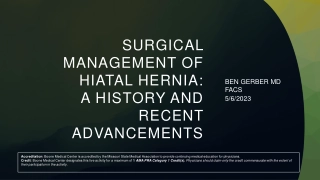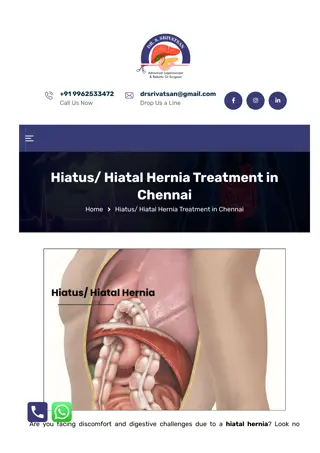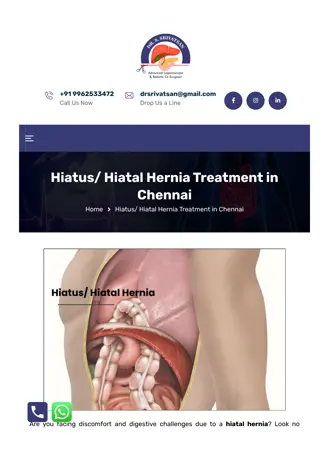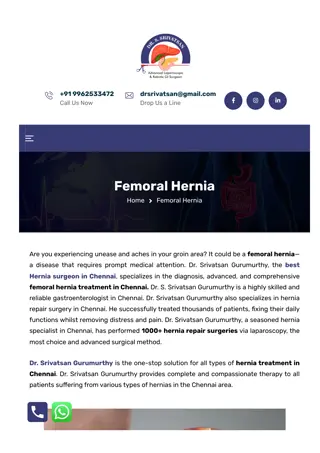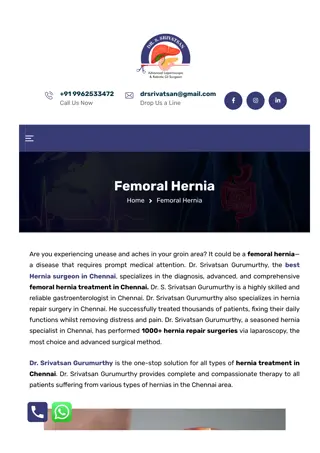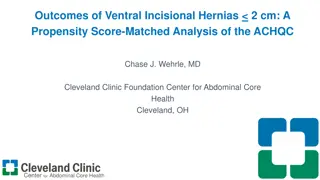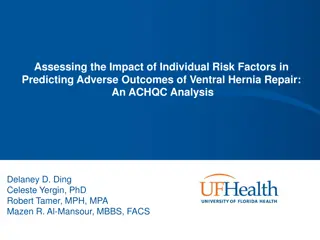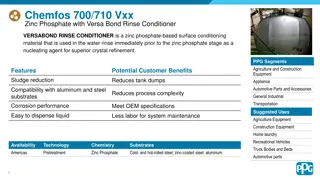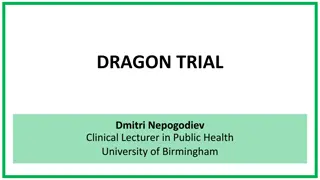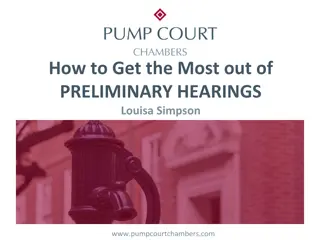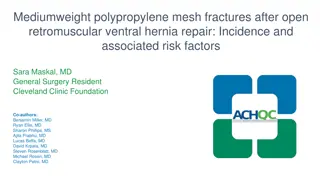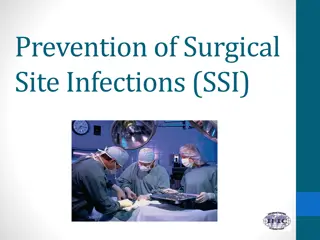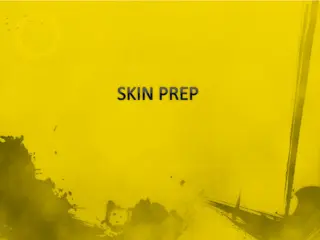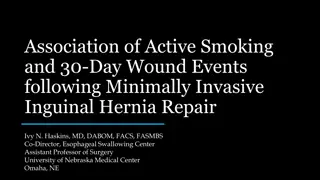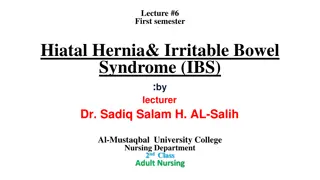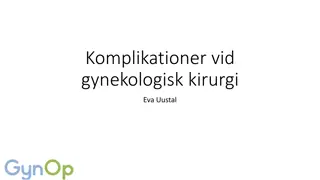Preliminary Outcomes of RINSE Trial for Reducing Surgical Site Infections in Ventral Hernia Repair
Jeremy Warren, MD, FACS from the University of South Carolina School of Medicine Greenville shares the preliminary outcomes of the RINSE trial aimed at reducing surgical site infections in ventral hernia repair. The trial explores the use of antibiotic irrigation and its effectiveness in decreasing SSI rates. Various studies and analyses are discussed, providing insights into the potential impact of antibiotic irrigation on post-operative infections in ventral hernia repair procedures.
Download Presentation

Please find below an Image/Link to download the presentation.
The content on the website is provided AS IS for your information and personal use only. It may not be sold, licensed, or shared on other websites without obtaining consent from the author.If you encounter any issues during the download, it is possible that the publisher has removed the file from their server.
You are allowed to download the files provided on this website for personal or commercial use, subject to the condition that they are used lawfully. All files are the property of their respective owners.
The content on the website is provided AS IS for your information and personal use only. It may not be sold, licensed, or shared on other websites without obtaining consent from the author.
E N D
Presentation Transcript
ReducINg Surgical SitE Infections in Ventral Hernia Repair: RINSE trial preliminary outcomes Jeremy Warren, MD FACS University of South Carolina School of Medicine Greenville Prisma Health Upstate
Disclosure Intuitive
Background Can antibiotic irrigation reduce the rate of SSI in VHR? What antibiotic(s) should be used? What technique (pulse lavage, timing, duration, etc)?
Background 56 patients evaluated prospectively 22 pos cultures pre-lavage; 4 after lavage (81.8% reduction) 19.6% SSI (n=11) 2 of 4 pos-pos (50%) 5 of 18 pos-neg (27.8%) 4 of 34 neg-neg (11.8%) Majumder A, Surg Techol Int 2015
Background RCT 103 pts Saline vs abx irrigation Peritoneal cultures RCT 103 pts Saline vs abx irrigation Peritoneal cultures Ruiz-Tovar, JACS 2012
Background Retrospective 852 patients no abx = 260; gent = 266; gent + clinda 299 Retrospective 852 patients no abx = 260; gent = 266; gent + clinda 299 Fatula, Am Surg 2018
Background Fatula, Am Surg 2018
Methods Subgroup analysis: RM +/- TAR, permanent synthetic mesh, excluding dirty wounds, excluding gent alone Subgroup analysis: RM +/- TAR, permanent synthetic mesh, excluding dirty wounds, excluding gent alone Abx (n=224) Saline (n=111) clean 10% 3.3% clean cont 16.7% 4% cont 40% 7.4% total 16.2% 4.5%
Methods Power analysis: 210 total patients Inclusion: elective open RM VHR +/- TAR with PP mesh; class 1-3 Exclusion: dirty wounds, alternate technique or mesh Multicenter embedded QC trial Cleveland Clinic Oregon Health Prisma Health Penn State Power analysis: 210 total patients Inclusion: elective open RM VHR +/- TAR with PP mesh; class 1-3 Exclusion: dirty wounds, alternate technique or mesh Multicenter embedded QC trial Cleveland Clinic Oregon Health Prisma Health Penn State
Results Demographics Demographics Group 1: Control Group 2: Antibiotic n Age; median (IQR) 125 62 (50.7-68) 125 59 (51.7-67) Female 56.8% 47.2% ASA 3 83.2% 81.6% BMI; median (IQR) 33.1 (29.2-36.2) 33.0 (29.2-37.1) HTN DM COPD Current smoker 56.8% 21.6% 10.4% 10.4% 61.6% 26.45 9.6% 10.4%
Results Hernia Characteristics Hernia Characteristics Group 1: Control Group 2: Antibiotic Incisional hernias Hernia width; median (IQR) 97.6% 14 (10-17) 95.2% 14 (10-16.3) Hernia length; median (IQR) 20 (15-24) 20 (15-24) ASA 3 83.2% 81.6% Modified VHWG grade 1 2 3 Recurrent hernia 15.2%% 63.2% 21.6% 63.2% 15.2% 68% 16.8% 52.8%
Results Operative Details Operative Details Group 1: Control Group 2: Antibiotic Wound class 1 78.4% 83.2% p=0.404 2 10.4% 10.4% 3 11.2% 6.4% Mesh used 99.2% 900cm2 (900-1012.5) 99.2% 99.2% 100% 900cm2(900-1376.0) p=0.398 100% 100% p=0.316 Mesh area; median (IQR) Mesh type, permanent synth Mesh placement; RM Myofascial release TAR Concomitant procedures p=.314 p=0.314 p=0.472 85.8% 19.2% 82.7% 16.8% p=0.621
Results Outcomes Outcomes Group 1: Control Group 2: Antibiotic Intraop complications bowel injury 6 (4.8%) 3 (2.4%) p=0.308 30-day SSI* 11 (9.9%) 10 (9.1%) p=0.836 Superficial 7 (63.6%) 4 (40%) Deep 4 (36.4%) 1 (9.1%) 8 5 2 0 5 (50%) 1 (10%) 8 5 2 3 Organ space SSIPI p=0.985 Wound opening Perc drainage Wound debridement * follow-up: Group 1 n=111, Group 2 n=110
Results Outcomes Outcomes Group 1: Control Group 2: Antibiotic 30-day SSO* 13 (11.7%) 15 (13.6%) p=0.667 Cellulitis 3 (23.1%) 2 (13.3%) Seroma Other 4 (30.8%) 6 4 (3.6%) 3 1 1 1 11 (9.9%) 6 (5.4%) 2 (33.3%) * follow-up: Group 1 n=111, Group 2 n=110 9 (60%) 4 4 (3.6%) 4 0 1 0 7 (6.4%) 1 (0.9%) 1 (100%) SSOPI p=0.990 Wound opening Perc drainage Wound debridement Partial mesh removal Readmission Reoperation Wound complication p=0.335 p=0.056
Summary Antibiotic irrigation did not reduce surgical site infection in open ventral hernia repair. Future study focusing on higher risk population should be considered. Antibiotic irrigation did not reduce surgical site infection in open ventral hernia repair. Future study focusing on higher risk population should be considered.
Future study R 30-day SSI (n=21) clean: n=13/202 (6.4%) clean-contaminated: n=1/26 (3.8%) contaminated: n=7/22 (31.8%) Is this the right antibiotic choice / method? 30-day SSI (n=21) clean: n=13/202 (6.4%) clean-contaminated: n=1/26 (3.8%) contaminated: n=7/22 (31.8%) Is this the right antibiotic choice / method?
